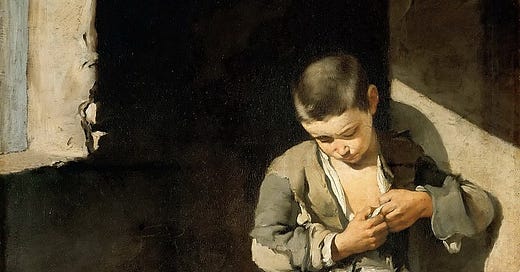As the foremost painter in his home city of Seville during the 17th century - Bartolomé Esteban Murillo was primarily known for painting religious subjects.
But personally, I think it is in his more human centred works - depicting the poor and the downtrodden of his generation - that we get an even greater sense of the extraordinary tenderness in his painting style.
With a painting like his “Young Beggar”, we see the artist’s sensitivity in full effect - perhaps heightened by a very personal experience too.
You see, Murillo’s parents had both died in his childhood, leaving the poor boy as an orphan before his 10th birthday.
And while he was fortunate enough to be taken into the care of his elder sister and close relatives - still, the unimaginable loneliness he must have felt at such a young age clearly left an indelible mark on him.
Thus, even when he was at the height of his artistic powers later in life, he still regularly returned to the theme of painting beggars, outcasts, or young “urchins”. . . almost if he still saw these people as his kindred spirits, far more than some of his other contemporaries in the art world.
However, with the painting we are featuring today - we have what is widely regarded as the first of Murillo’s “Urchin” paintings . . . dating from around 1645-1650, when the artist himself would have still only been in his late twenties or early thirties.
The subject is highly contemporary to the 17th century - showing us a young boy trying to rid himself of lice, at a time when poverty was absolutely rampant on the streets of Seville. And of course, the influence of Murillo’s hero Michelangelo Merisi da Caravaggio could hardly be more apparent, with those dark shadows in the background contrasting with the heavenly light which illuminates our young beggar.
But equally, there is a tragic kind of timelessness about this image too; because of course, children like this have existed in every era - including our own.
Thus, Murillo’s work speaks to us now with just as much emotional force as he did to his own generation almost 400 years ago.
And while the obvious message of a work like this is essentially “don’t ignore” or “don’t look away from the plight of these people” . . . I think Murillo is also making another more spiritual point here too.
He is saying that there may be lice on this poor boy’s skin, and dirt on the soles of his feet . . . but make no mistake, the child is touched by just as much grace as any of the religious figures who appear in all those more commercially popular works of the time.
Thus, the boy embodies a central element of the Murillo’s own faith.
The privileged may have their way in this life . . . but one day, it is the poor and the lonely and the meek who will be exalted.







A wonderful statement of what we call empathy, the recognition of ourselves in the plight of others. In today,s society we tend to ignore our common humanity, forsaking our common humanity. That is how we cease to be human. Art is a reminder to be better.
There but for the grace of God, go I.